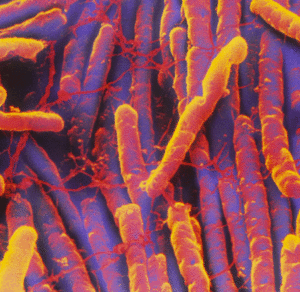 In a recent study, two different strains of non-toxigenic Clostridium difficile provided protection against both historic and epidemic C. difficile strains. The research was conducted by researchers at Hines VA Hospital and is published ahead of print in the journal Antimicrobial Agents and Chemotherapy.
In a recent study, two different strains of non-toxigenic Clostridium difficile provided protection against both historic and epidemic C. difficile strains. The research was conducted by researchers at Hines VA Hospital and is published ahead of print in the journal Antimicrobial Agents and Chemotherapy.
Studies show colonization with a non-disease-causing strain of C. difficile can prevent infection by the more dangerous strains. Patients who are not colonized by benign strains may risk become infected by the harmful strains. The harmless strains occupy the same niches in the intestine that the infective strains would take if the harmless strains weren’t there.
In order to determine which strains provided protection researchers first treated the hamsters with an oral antibiotic to clear their systems, then colonized with one of two strains (M3 or T7) of non-toxigenic C. difficile. The hamsters were then challenged with a colonizing dose of one of two toxigenic strains (BI1 or BI6) representing both historical and current epidemic C. difficile.
All of the hamsters colonized with either non-toxigenic strain were able to prevent infection with the historic, fatal BI1 strain. Additionally, all of the hamsters colonized with M3 were able to prevent co-infection by BI6. However, “despite 100 percent colonization with the T7 non-toxigenic strain, five of ten hamsters became co-colonized with the toxigenic strain BI6 following challenge, and four of these died,” says Johnson. Overall, M3 provided better protection against the fatal strains tested.
“If the findings in the hamster model of C. difficile infection can be replicated in humans, then we may have a new means of protecting susceptible, high-risk patients – notably hospitalized patients treated with antibiotics – or preventing relapsing disease in patients who have recovered from treatment for C. difficile,” says Stuart Johnson, an author of the study. Around 25 percent of first-time patients have a recurrence of the infection.
Improvements still are needed, but the hamster study suggests that they can be achieved. “Further analysis of the phase II clinical trial will be needed to help validate the findings in this study showing protection of virulent epidemic BI-associated infections with non-toxigenic C. difficile,” says Johnson.
Source: Gerding et Al. Non-toxigenic Clostridium difficile vs BI/NAP1/027. Antimicrobial Agents and Chemotherapy, October 2013














